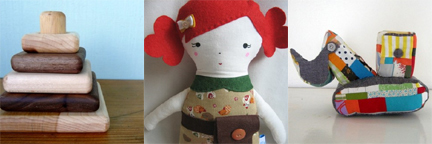
I think not. I am completely unqualified to weigh in on this issue, but I will anyway. If you are unfamiliar with the controversy, Congress has passed an act called the Consumer Product Safety Improvement Act of 2008, created to protect American consumers from lead and other harmful materials in children’s toys and clothing. It will go into effect next month and would allow the Consumer Product Safety Commission (CPSC) to require rigorous testing of toys, clothing and other children’s items.
Though well intended, the Act has several flaws. For one, the Act requires regulation of American toy manufacturers and importers, placing the financial burden on our economy when I fully believe that the pressure for regulation should be on China, since we all know who is putting lead in our toys. In addition, the wording of the Act is incredibly vague and open to interpretation. I think this was intentional to allow the CPSC to regulate as it sees fit. But it’s causing mass hysteria in the handmade world.
So, how does this actually affect handmade children’s clothing and toys? The testing required is prohibitively expensive for small toy makers. I don’t believe that the CPSC will have the inclination or the resources to regulate your average toy maker on Etsy or at craft fairs, but this could negatively impact some smaller toy manufacturers. And still, it would mean that toy makers are technically breaking the law if they don’t have their toys tested, so a provision should be made to the Act exempting small-scale toy makers.
The owners of thrift stores across the country protested the new requirements because they would have prohibited the selling of used toys that didn’t meet the new safety standards. In response, the CPSC announced yesterday that thrift stores and items made of natural materials like wood and cotton would be exempt. An article in the LA Times quotes a statement from the regulators:
“The agency intends to focus its enforcement efforts on products of greatest risk and largest exposure.”
An earlier article from the LA Times quotes Scott Wolfson, a CPSC spokesman:
“The CPSC is an agency with limited resources and tremendous responsibility to protect the safety of families. Our focus will be on those areas we can have the biggest impact and address the most dangerous products.”
To me, this means that small-scale toy makers need not worry. As currently written, the Act overreaches its intended purpose and is unfeasible to enforce. So it would be nice if the ninnies in our Congress would clarify the wording to reflect the way the regulations will actually work. If you’d like to try to make a difference, you can write a letter, add a button to your blog (available at Cool Mom Picks), or visit the Handmade Toy Alliance for more information.
I’m not an alarmist. So I don’t think anyone should panic and burn all of their handmade toy inventory. I just feel that common sense is certain to prevail here. Am I too optimistic to expect this from our government? Perhaps.
Pictured above:
Maple/Walnut Stacking Toy, $26 from Little Sapling Toys.
Big Sister Sandy Sprinkles Red Hair Rag Doll, $36 from Lil Sprinkles.
Patchwork Digger, $70 from Elsie Marley.

Thank you so much for featuring us.
So very well explained and written. Thanks so much for your support!
lil sprinkles
This is a bit scary, although I do agree with you about optimism for us handmade small scale toy makers. I am hoping the outcry over this will cause quite a few revisions. Thanks for explaining it so well!
There’s a follow-up here:
http://www.kval.com/news/37241774.html
And I agree, it was meant for items coming from oversees, not the small-scale crafters and second-hand shop owners.
Thank you for the posted follow up, Andrea. It appears that common sense may actually have a chance here. What a refreshing change!
I agree with you 100%. I’ve worked as an industrial designer designing toys, accessories and other such juvenile products and I’ve seen this hit the industry hard–many, even the top players, are losing money on this bill. This just does not include toys, this includes shoes, bags, apparel with made with materials that could potentially have lead in them, like cheap rhinestones, pvc, paint and other such things.
What should be noted though is that there are times when overseas factories do a switch and bait, and replace approved and safer materials with cheaper materials–which should be illegal. I agree that tougher enforcement should be laid on overseas factories as THEY are the ones physically making everything the consumers buy. THEY are the ones in charge of raw materials. THEY are the ones putting everything together. And with factors such as lead content, food poisoning (ie, melamine in powdered milk and candies) and others, THEY should be regulated AS WELL AS the companies that design and outsource the manufacturing.
From personal experience, I have tested toys for both children and pets and the lowest price I’ve been charged from these private agencies has been 200.00 per item. Not feasible for a small business person with low volume capacities and low revenue.
I’d also like to add the argument here could be that sometimes, even when something is locally made, the raw materials use could be tainted (generic rhinestones, pvc, paint, etc…), and I feel like parents should be aware of this. So I also think there should be a separate organization–a non profit that provides low-cost testing for low volume, locally manufactured products. Like authorized watchdogs that safeguard local factories.
I’m not sure what the ultimate answer is, but I feel like this bill shouldn’t blanket the entire juvenile manufacturing sector as there are many factors to consider.
Oh and by the way, these agencies that test toys and whatnot are PRIVATE entities. Not everyone is a Mattel or a Fisher Price and can afford testing agency prices. There are micro business that are barely surviving and as mentioned, I believe a separate non-profit agency, small business grants and/or a new federal agency should help out in regards to testing regulations.
Gosh. Sorry for the long comment/ramble! I specialize in infant and juvenile design so this is a hot topic within the industry right now. But thanks for bringing it up. I don’t think that this is the end of the industry…Just a VERY expensive change that should be more accommodating to small business owners and the like.
Yes. As pointed out by aprintaday, many things made locally use materials made in China. Almost everything sold in craft stores is made in China. So is fabric. Parents could be made aware of this with some type of special label. Or we could all just stop buying stuff from China. I’ve tried. But it’s hard.
totally!
oh and have you read this book? http://www.amazon.com/Year-Without-Made-China-Adventure/dp/0470116137
it is a VERY interesting, eye-opening read. it chronicles a family’s choice to not purchase made in china goods for a year, and it is definitely hard–but not impossible of course. the mom (the narrator who is a journalist as well) is quite funny too.
This LA times article you referred to is frustrating to me
http://www.latimes.com/business/la-fi-lead7-2009jan07,0,6917858.story
because it leads one to think cotton fabric would be exempt but in the actual vote they are clear about it being completely untreated cotton fabric
“The staff recommends that these findings only apply to a material that is untreated and unadulterated by the addition of materials or chemicals including pigments, dyes, coats, finishes or any other substance, and has not undergone any processing that could result in lead content that exceeds the CPSIA lead limits” here’s the vote
http://www.cpsc.gov/cpscpub/prerel/prhtml09/09086.html
I do hope that this is a sign that they will be making more exemptions for small business. I don’t think they will exempt anyone entirely though. I hope they will allow component testing because I would by my buttons zippers etc. from a company that could prove their items were safe and then we the small manufacturer could use their certification as proof.
As far as Ebay and Etsy go, they have said they won’t allow the sale of any banned item and technically anything that’s not proved to be safe will fall under the banned item definition. I don’t think they’ll catch everyone but I think it will be a matter of people turning sellers in who don’t show certification. we’ll see…
This does not only apply to toys, but to all children’s products, including clothing and books. Clothing makers would not be allowed to just show that the raw materials were tested by the manufacturer (if the manufacturer had performed the tests). As you mentioned on etsy, there is mass hysteria. Things may get worked out, but for a lot of people it is causing a lot of problems. It is not easy to keep calm when you don’t know if you will still have a business a month from now.